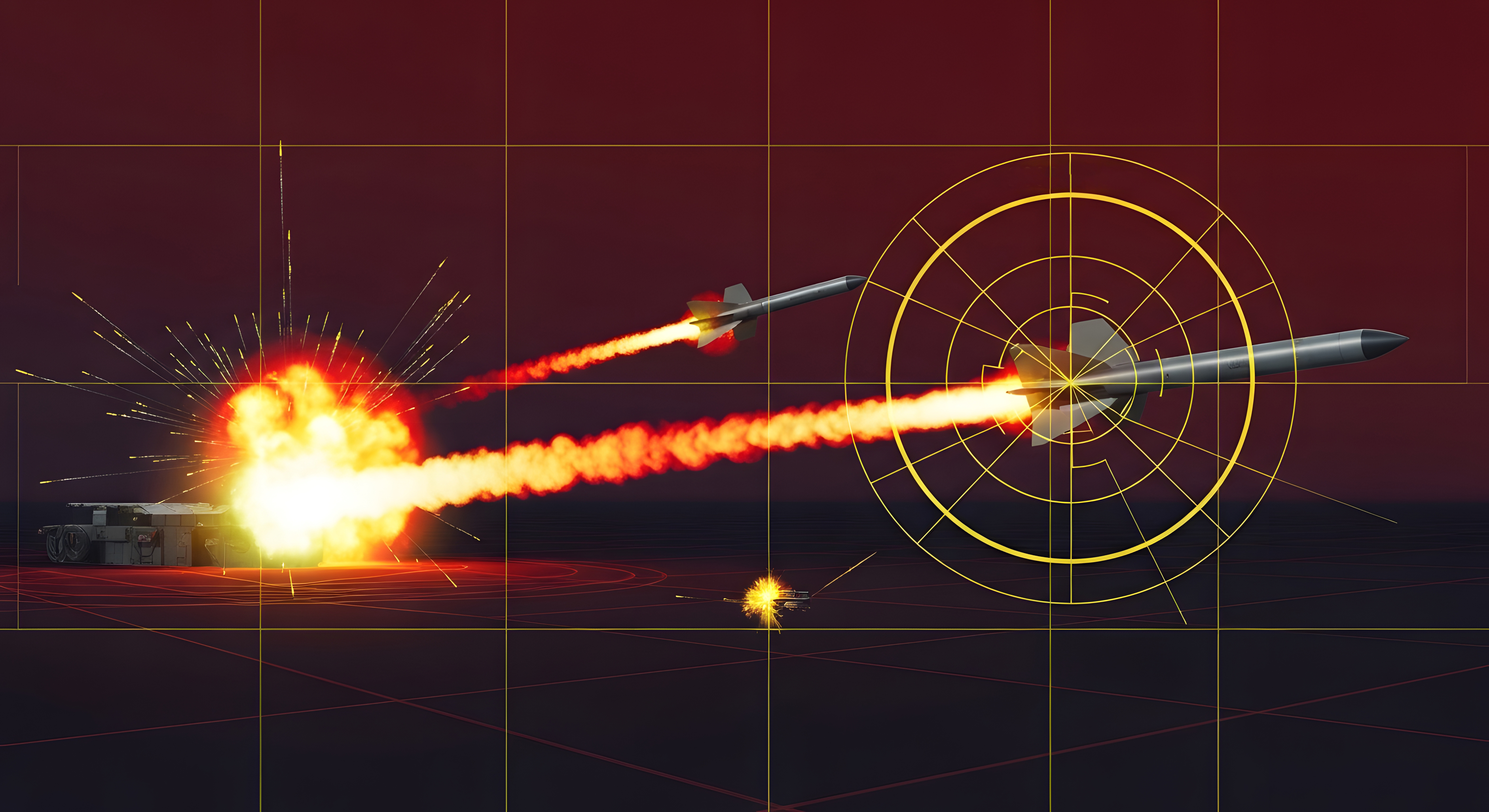Missile guidance remains one of the most demanding engineering disciplines in aerospace and defense, where microsecond decisions determine mission success or failure. The convergence of complex flight dynamics, sophisticated threat environments, and unforgiving reliability requirements creates a technical challenge that pushes the boundaries of control theory, sensor fusion, and computational capability.
The global missile guidance system market was valued at USD 12.5 billion in 2025 and is expected to grow to USD 19.8 billion by 2032 at a CAGR of 6.5%, even as the industry faces supply chain constraints, regulatory complexity, and economic fluctuations affecting system deployment
Unique Engineering Complexity of Missile Guidance
Modern missile engagements unfold across three distinct flight phases, each with its own technical challenges:
- Boost Phase – Compensate for propulsion disturbances and establish a stable trajectory foundation despite high acceleration forces.
- Midcourse Phase – Maintain navigation accuracy over extended distances using inertial navigation systems (INS) or external updates, while minimizing drift and error accumulation.
- Terminal Phase – Rapidly acquire the target and compute precise intercept geometry under severe time constraints.
Additional adversarial challenges include:
- Electronic Warfare Resistance – Counter jamming, spoofing, and other signal-degrading tactics.
- Multi-Environment Performance – Maintain guidance accuracy in diverse atmospheric, electromagnetic, and threat conditions.
Major Missile Guidance Challenges Today
Guidance systems face technical challenges at every engagement stage from sensing accuracy to adapting to evasive maneuvers. Each challenge represents a fundamental physics or engineering constraint that cannot be simply engineered away through incremental improvements.
1. Dynamic Flight Environment & Maneuvering Targets
Modern threats execute high-G evasive maneuvers that create rapidly changing line-of-sight rates and complex kinematic relationships. Intercepting agile targets requires guidance systems to predict future positions while accounting for both interceptor and target acceleration limitations. The challenge intensifies with hypersonic threats, where traditional proportional navigation laws break down due to extreme closing velocities and compressed decision timelines.
Target maneuverability creates a pursuit-evasion game where the guidance system must not only predict optimal intercept geometry but also anticipate and counter evasive strategies. This dynamic interplay demands adaptive algorithms capable of real-time strategy modification based on observed target behavior.
2. Sensor Noise, Estimation Errors & Uncertainty
Seeker systems operate in harsh electromagnetic and physical environments, introducing measurement noise that degrades guidance accuracy. Traditional Kalman filtering approaches assume Gaussian noise models and linear system dynamics assumptions that rarely hold in real engagement scenarios. Model mismatch between assumed and actual system behavior compounds these issues, leading to suboptimal state estimation and guidance commands.
Uncertainty propagation through the guidance loop creates additional challenges. Small estimation errors at the beginning of an engagement can cascade into significant miss distances, particularly for long-range intercepts where error accumulation has more time to develop.
3. Control Loop Stability & Actuator Constraints
The coupling between seeker dynamics and missile body dynamics creates complex stability challenges that require careful control system design. Parasitic coupling can introduce unwanted oscillations or instabilities that degrade tracking performance, particularly during high-G maneuvers when aerodynamic loading is greatest.
Actuator bandwidth limitations impose additional constraints on guidance system performance. Fin actuators have finite response times and authority limits that must be considered in guidance law design. The interaction between autopilot dynamics and guidance commands requires careful analysis to ensure closed-loop stability across all flight conditions.
4. Guidance System Resilience to Jamming & Countermeasures
Modern electronic warfare environments present sophisticated threats to guidance system sensors. GPS signals can be jammed or spoofed, infrared seekers can be confused by flares or directed energy, and radar seekers face chaff, electronic jamming, and stealth technologies. The challenge extends beyond simply detecting interference guidance systems must maintain effectiveness while operating with degraded or corrupted sensor information.
Multi-spectral countermeasures can simultaneously attack multiple sensor modalities, forcing guidance systems to operate with severely limited information. This environment demands robust sensor fusion architectures and adaptive guidance algorithms capable of maintaining performance with partial sensor degradation.
5. Legacy Guidance Law Limitations (e.g. PNG, Q-Guidance)
Proportional navigation guidance (PNG) and its variants have served as the backbone of missile guidance for decades, but these classical approaches show fundamental limitations in modern threat environments. PNG assumes constant target velocity and linear engagement geometry assumptions that break down against maneuvering targets or in complex multi-body engagements.
Q-guidance and other classical methods rely on predetermined gain schedules and fixed control strategies that cannot adapt to unexpected threat behaviors or environmental conditions. These static approaches lack the flexibility needed to counter adaptive adversaries employing unpredictable evasive maneuvers.
6. Integration Complexity in Hybrid Guidance & Control Architectures
Modern guidance systems integrate multiple navigation sources including inertial navigation systems (INS), terrain reference systems (TRS), GPS, and various seeker technologies. Each sensor modality has different error characteristics, update rates, and reliability profiles that must be carefully balanced in the fusion architecture.
The integration challenge extends beyond sensor fusion to include machine learning predictors, adaptive control elements, and real-time optimization algorithms. Managing the computational load, ensuring deterministic real-time performance, and maintaining system certifiability across this complex architecture requires sophisticated system engineering approaches.
Traditional Guidance Approaches & Where They Fall Short
Command guidance systems, including beam riding and manual command to line-of-sight (MCLOS), rely on external guidance sources to direct the missile to target. While these approaches can provide high accuracy for certain engagement scenarios, they suffer from range limitations, operator workload issues, and vulnerability to countermeasures targeting the command link.
Semi-automatic command to line-of-sight (SACLOS) and other operator-assisted guidance modes reduce human workload but still depend on external sensors and communication links. These systems face fundamental limitations in beyond-visual-range engagements and high-threat environments where communication links may be jammed or compromised.
The operator-centric nature of these traditional approaches also introduces human factors limitations, including reaction time delays and performance degradation under stress, areas now improved through quantum technology in aerospace applications.Modern threat timelines often exceed human response capabilities, necessitating more autonomous guidance approaches.
Innovations & Emerging Solutions in Guidance Control
Reinforcement Learning (RL)-Based Guidance Laws represent a paradigm shift from classical control approaches. RL-based systems learn optimal guidance strategies through interaction with simulated environments, developing adaptive behaviors that can handle uncertainty and unexpected target maneuvers. These systems demonstrate improved robustness and reduced miss distances compared to traditional approaches, particularly against non-cooperative targets employing unpredictable evasive strategies.
Deep Learning + Predictive Control (NMPC-TAP) combines LSTM-based trajectory prediction with nonlinear model predictive control to create guidance systems capable of anticipating agile threat maneuvers. This approach leverages pattern recognition to predict target behavior while maintaining the optimality guarantees of model predictive control frameworks.
Neuro-Evolution and Meta-Reinforcement Learning approaches develop generic pursuit-evasion control strategies through evolutionary optimization of reward functions. These methods can adapt to new threat types without requiring extensive retraining, providing flexibility crucial for countering evolving adversary capabilities.
Adaptive & Finite-Time Error Dynamics Guidance addresses timing uncertainties and angle error constraints through convergent control laws that guarantee performance within specified time windows. These approaches provide mathematical guarantees on guidance system performance while maintaining adaptability to changing engagement conditions.
Role of Simulation and Advanced Testing in Overcoming Challenges
High‑performance simulation platforms enable comprehensive validation of guidance algorithms across thousands of engagement scenarios.Quantum-inspired solvers accelerate the optimization loops required for guidance law tuning, enabling exploration of design spaces that were previously computationally intractable.
- Comprehensive Algorithm Validation – High‑performance simulation platforms allow testing of guidance algorithms across thousands of realistic engagement scenarios.
- Accelerated Design Optimization – Quantum-inspired solvers speed up optimization loops for guidance law tuning, enabling exploration of complex design spaces that are too large for traditional methods.
- Realistic Threat Modeling – Advanced environments simulate sophisticated countermeasures such as jamming, spoofing, and multi-spectral interference, which are difficult and costly to replicate in flight tests.
- Secure, Cost‑Effective Testing – Enables stress-testing algorithms under classified or extreme conditions without the expense or risk of live-fire trials.
- Multi-Parameter Design Exploration – Automated optimization identifies robust operating points across varying sensor configurations, control strategies, and environmental conditions.
Future Outlook: Roadmap to Resilient Missile Guidance
The integration of AI and machine learning into guidance systems will continue accelerating, driven by the need to counter increasingly sophisticated threats.Future guidance architectures will leverage hybrid sensing approaches that combine traditional sensors with AI-driven environmental understanding and quantum evolutionary algorithms for adaptive mission optimization.
Rigorous validation pipelines and digital twin frameworks will become essential for certifying AI-powered guidance systems for operational deployment. The challenge lies in developing verification and validation approaches that can provide confidence in adaptive systems whose behavior emerges from training rather than explicit programming.
Robustness certification will require new mathematical frameworks that can bound the performance of learning-based systems under adversarial conditions. This represents a fundamental shift from traditional control system verification approaches and will require close collaboration between control theorists, machine learning researchers, and certification authorities.
How BQPhy Supports Innovation in Missile Guidance R&D
BQPhy provides defense R&D teams with advanced quantum‑inspired tools and simulation capabilities to design, test, and optimize guidance systems faster and with greater resilience against modern threats.
- Faster Iterative Design Loops – Quantum‑inspired optimization solvers accelerate multi‑objective design iterations, reducing development timelines from months to weeks.
- Hybrid Quantum‑Classical Exploration – Rapidly search vast guidance law parameter spaces that are computationally impractical for classical methods alone.
- Physics‑Informed Neural Networks (PINNs) – Embed aerodynamic and kinematic constraints directly into guidance law training for higher physical accuracy.
- Quantum‑Assisted PINNs (QA‑PINNs) – Improve performance in sparse‑data environments such as rare failure events or extreme threat conditions.
- Real‑Time Performance Tracking – Continuously monitor convergence metrics, compare approaches, and dynamically adjust simulation parameters for robustness.
- Secure, Cross‑Functional Collaboration – Maintain strict access controls while enabling multidisciplinary teams to work together effectively on sensitive projects.
Advance your guidance law design with secure, fast, and accurate simulation- Book a demo
Conclusion—Meeting the Missile Guidance Challenge Head-On
The missile guidance challenge represents one of the most complex engineering problems in modern aerospace and defense, where classical approaches are reaching fundamental performance limits. The convergence of AI‑driven adaptive control, advanced simulation platforms, and quantum-inspired optimization creates unprecedented opportunities to develop guidance systems capable of operating effectively in tomorrow's threat environments.
Success in this domain requires more than incremental improvements—it demands fundamental advances in how we approach guidance system design, validation, and deployment.. The integration of machine learning, adaptive control, and advanced simulation represents the pathway to guidance systems that can match the sophistication of emerging threats.
FAQs
1. What are the key challenges in modern missile guidance?
Modern missile guidance faces challenges like uncertain flight environments, high-speed maneuvering, and dynamic target behavior that demand adaptive control and real-time optimization.
2. How do quantum-inspired methods improve missile guidance?
Quantum-inspired optimization accelerates trajectory computation and enables adaptive control, helping guidance systems respond faster and more precisely in unpredictable conditions.
3. Why is simulation important for missile guidance research?
Simulation helps engineers test guidance algorithms under varied combat and atmospheric conditions safely and cost-effectively before live deployment.
4. What makes BQPhy different from traditional modeling tools?
BQPhy integrates quantum-inspired algorithms with high-fidelity physics models, enabling faster convergence and superior prediction accuracy compared to conventional methods.
5. How does AI contribute to missile guidance?
AI enables adaptive learning in guidance systems, allowing them to handle uncertain conditions, improve targeting precision, and optimize fuel efficiency in real time.





.png)
.png)
%20365382.png)




.svg)
.svg)
.svg)
.svg)